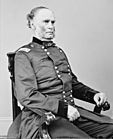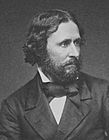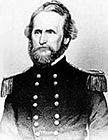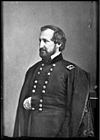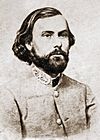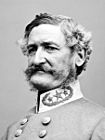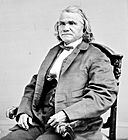Trans-Mississippi theater of the American Civil War facts for kids
The Trans-Mississippi theater of the American Civil War was where many important military actions happened west of the Mississippi River. This area usually doesn't include the states and territories along the Pacific Ocean, which had their own separate war events.
The National Park Service has a very detailed way of classifying these events. This article simplifies some of those details. We will only talk about a few of the many battles that happened in this theater.
In 1861, much of the fighting here was about the state of Missouri. It was a "border state," meaning it was caught between the Union and the Confederacy. The Missouri State Guard, which supported the Confederacy, won big battles at Wilson's Creek and the First Battle of Lexington. But they were pushed back at the First Battle of Springfield.
A Union army, led by Samuel Ryan Curtis, won the Battle of Pea Ridge in Arkansas in March 1862. This helped the Union control most of Missouri. Areas like Missouri, Kansas, and the Indian Territory (which is now Oklahoma) saw a lot of guerrilla warfare. This means small groups of fighters used surprise attacks instead of large battles. A famous event was the Lawrence massacre in August 1863, where many people in the Union-supporting town of Lawrence, Kansas were killed.
In the spring of 1862, Confederate forces under Henry Hopkins Sibley moved north from El Paso, Texas into New Mexico Territory. They won at the Battle of Valverde, but were stopped at the Battle of Glorieta Pass in March 1862.
By 1863, General Edmund Kirby Smith took charge of the Confederate forces in this western area. He tried to help the city of Vicksburg during its siege by Union General Ulysses S. Grant. But Vicksburg fell in July 1863. This gave the Union control of the entire Mississippi River, splitting the Confederacy in two. The Trans-Mississippi Department became cut off from the rest of the Confederate states. People even called it "Kirby Smithdom" because the main Confederate government had little control there.
In 1864, the Red River Campaign saw Union forces try to take control of northwestern Louisiana. But Confederate troops, led by Richard Taylor, stopped them. Later, Major General Sterling Price tried to win Missouri back for the Confederacy in what was called Price's Raid. But his troops were defeated at the Battle of Westport in October.
On June 2, 1865, after most other Confederate armies had given up, Kirby Smith officially surrendered his command in Galveston, Texas. On June 23, Stand Watie, a Confederate general leading troops in the Indian Territory, was the very last Confederate general to surrender.
Contents
Confederate Arizona and New Mexico Territory
In 1861, the Confederate States Army moved into the New Mexico Territory. This area included parts of what are now Arizona and New Mexico. People in the southern part of this territory wanted to join the Confederacy. They asked Confederate soldiers from Texas to help them remove Union forces.
The Confederate Territory of Arizona was declared by Colonel John R. Baylor after his victories. This included the First Battle of Mesilla on July 25, 1861. Confederate forces then moved north, taking Albuquerque and Santa Fe in March 1862. However, they couldn't go further north. Union soldiers from California arrived, and the Confederates left Arizona completely in 1862.
The Battle of Glorieta Pass happened from March 26–28, 1862. It was a small fight, but it was very important. If the Confederates had won, they might have taken Fort Union and even Denver. One Texan soldier said, "If it had not been for those devils from Pike's Peak, this country would have been ours." This battle stopped the Confederacy from taking New Mexico and the far western territories.
In April, Union volunteers from California, called the California Column, pushed the last Confederates out of Arizona. This happened at the Battle of Picacho Pass. The Civil War continued for three more years in the eastern United States. But in the Southwest, the war against the Confederacy was over.
Missouri, Arkansas, and Kansas Conflicts
Missouri was a slave state, and some people there strongly supported the Confederacy. However, most Missourians sided with the Union. The pro-Confederate Governor Claiborne F. Jackson and his state guard, led by General Sterling Price, joined forces with Confederate General Ben McCulloch. They won battles at Wilson's Creek and Lexington. But large Union forces arrived in February 1862. The Confederates were then defeated at the Battle of Pea Ridge, Arkansas, from March 6–8. This pushed them out of Missouri.
A difficult guerrilla war then started in Missouri. Groups of Confederate fighters, known as "bushwhackers," attacked Union troops and local Union militias. Much of this fighting was between Missourians who supported different sides. Both sides caused great hardship for civilians. Many of the most well-known bushwhacker leaders were William C. Quantrill and William T. "Bloody Bill" Anderson. Some of their followers, like Jesse James and his brother Frank James, continued their actions for many years after the war.
The guerrilla fighting in Missouri during the Civil War was very intense. Historians believe that about twenty-seven thousand Missourians died in the violence.
Kansas became a free state on January 29, 1861, just before the war began. In August 1863, Quantrill led his raiders into Kansas. They destroyed much of the city of Lawrence and killed over 150 unarmed men and boys. This event is known as the Lawrence Massacre.
On October 25, 1864, during Confederate Major General Sterling Price's raid into Kansas and Missouri, his forces were defeated. This happened in three connected battles: Marais des Cygnes, Mine Creek, and Marmiton River. The Battle of Mine Creek was one of the largest cavalry (horseback soldier) fights of the war. These defeats ended Price's campaign and forced him to retreat.
Texas and Louisiana Operations
The Union tried several times to capture parts of Texas and Louisiana from 1862 until the end of the war. With ports to the east blocked or captured, Texas became a key place for "blockade-running". This meant ships tried to sneak past Union blockades to bring supplies. Texas and western Louisiana were called the "back door" of the Confederacy. They continued to produce cotton, which was sent overland to Mexican towns like Matamoros. From there, it was shipped to Europe in exchange for supplies.
The Union wanted to stop this trade, so they tried to invade Texas many times, but they were never successful. Confederate victories at Galveston, Texas, the Battle of Sabine Pass, and the Second Bayou Teche Campaign pushed back these invasion forces.
The Union's difficult Red River Campaign in western Louisiana, including a defeat at the Battle of Mansfield, was their last major attempt to invade the region. The war in the Trans-Mississippi theater continued at a lower level for several months after General Lee surrendered in April 1865. The very last battle of the war happened at Palmito Ranch in southern Texas from May 12–13. The Confederates won this final battle.
Indian Territory Conflicts
Indian Territory was a large area that is now most of Oklahoma. It was set aside for Native American tribes who had been moved from their original lands. This area saw many small fights and seven official battles. These involved Native American units who sided with the Confederacy, Native Americans loyal to the United States, and Union and Confederate troops.
A campaign led by Union General James G. Blunt aimed to secure Indian Territory. It ended with the Battle of Honey Springs on July 17, 1863. While his force included Native Americans, the Union did not officially add Native American soldiers to its regular army. About 7,860 officers and soldiers from Native American lands fought for the Confederacy. They mostly came from the Cherokee, Chickasaw, Choctaw, Creek, and Seminole nations.
One important leader was Brig. Gen. Stand Watie, a Cherokee. He led his 1st Cherokee Mounted Rifles regiment in guerrilla warfare, attacking Union positions and supply wagons. He also attacked other Cherokee and Native Americans who supported the Union. Stand Watie was the last Confederate General to surrender. He signed a cease-fire agreement with Union representatives on June 23, 1865.
Trans-Mississippi Department Overview
The Confederate States Army created the Trans-Mississippi Department on May 26, 1862. It included Missouri, Arkansas, Texas, Indian Territory (now Oklahoma), and Louisiana west of the Mississippi River. This department took over from an earlier one that had been formed in January 1862. The main headquarters for this combined department were in Shreveport, Louisiana, and Marshall, Texas.
Important Union Commanders
-
Maj. Gen.
Nathaniel P. Banks,
USA -
Maj. Gen.
James G. Blunt,
USA -
Maj. Gen.
Edward Canby,
USA -
Maj. Gen.
Samuel R. Curtis,
USA
-
Maj. Gen.
John C. Frémont,
USA -
Maj. Gen.
Nathaniel Lyon,
USA -
Maj. Gen.
John Pope,
USA -
Maj. Gen.
William S. Rosecrans,
USA -
Maj. Gen.
John Schofield,
USA
Important Confederate Commanders
-
Gen.
Edmund Kirby Smith,
CSA -
Lt. Gen.
Theophilus H. Holmes,
CSA -
Lt. Gen.
Richard Taylor,
CSA -
Maj. Gen.
Thomas C. Hindman,
CSA -
Maj. Gen.
John B. Magruder,
CSA
-
Maj. Gen.
Sterling Price,
MSG, CSA -
Brig. Gen.
Benjamin McCulloch,
CSA -
Brig. Gen.
Stand Watie,
CSA
See also
 In Spanish: Teatro Trans-Misisipi para niños
In Spanish: Teatro Trans-Misisipi para niños





